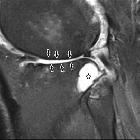subchondrale Zysten









Geodes, also known as subchondral cysts, are well-defined lytic lesions at the periarticular surfaces. A geode is one of the common differential diagnoses of an epiphyseal lesion (lytic).
Epidemiology
Associations
Geodes are seen in a small group of disorders including:
- degenerative joint disease (DJD)
- rheumatoid arthritis
- calcium pyrophosphate dihydrate crystal deposition disease (CPPD)
- avascular necrosis
Pathology
Presumably, one method of geode formation takes place when synovial fluid is forced into the subchondral bone, resulting in a cystic collection of joint fluid. Another etiology is that following a bone contusion, the contused bone forms a cyst.
Treatment and prognosis
They rarely cause problems by themselves but are often misdiagnosed as something more sinister and an unnecessary biopsy of a geode might be performed on the basis of the differential of an epiphyseal lesion.
History and etymology
Geode is a term borrowed from "geology", where it refers to rounded formations in igneous and sedimentary rocks.
See also
Siehe auch:
- Aseptische Knochennekrose
- Rheumatoide Arthritis
- intraossäres Ganglion
- Kalziumpyrophosphat-Ablagerungskrankheit
- degenerative subchondrale Knochenzyste
- Knochenläsionen der Epiphyse
- Geode vs intraossäres Ganglion
- subchondrale Insuffizienzfraktur
- Mikrogeodische Erkrankung Finger
- degenerative joint disease (DJD)
und weiter:

 Assoziationen und Differentialdiagnosen zu subchondrale Zysten:
Assoziationen und Differentialdiagnosen zu subchondrale Zysten:




